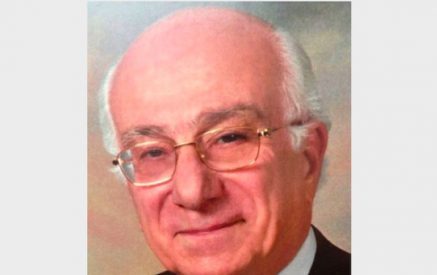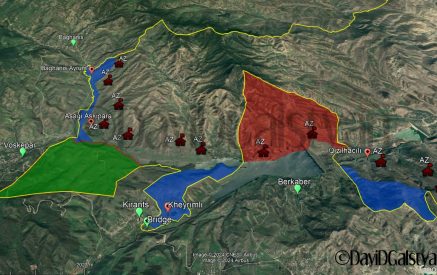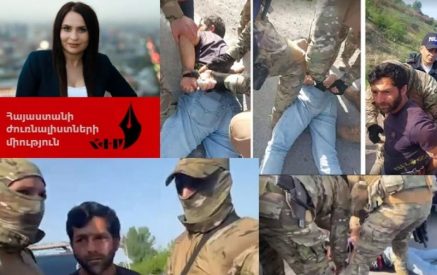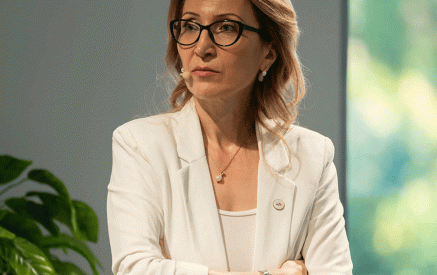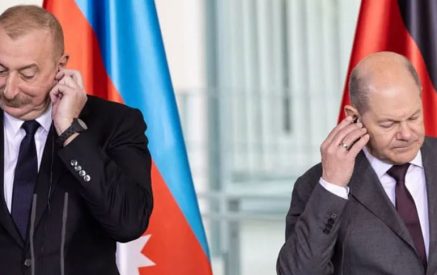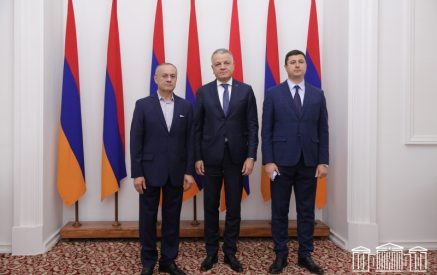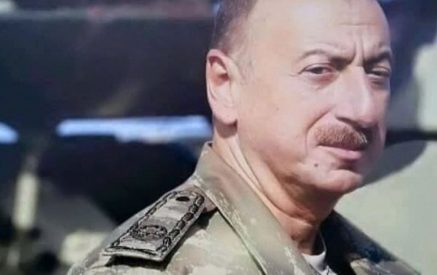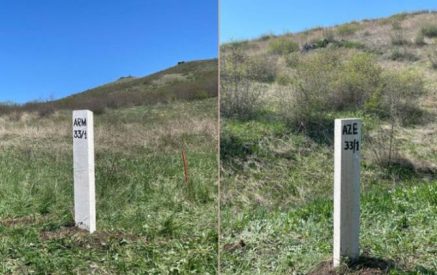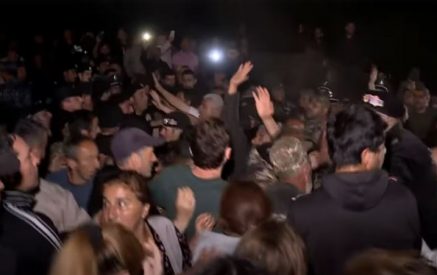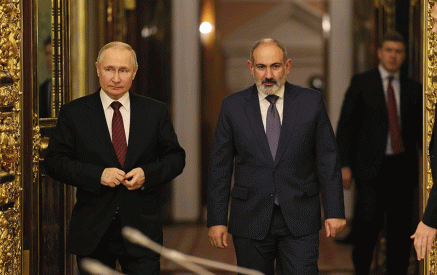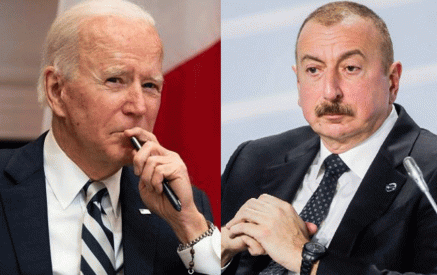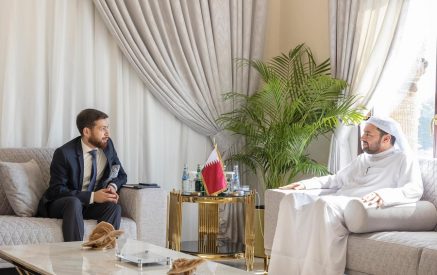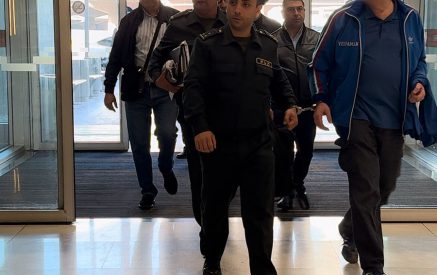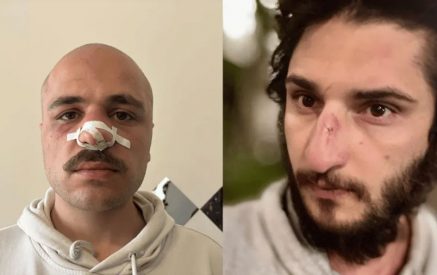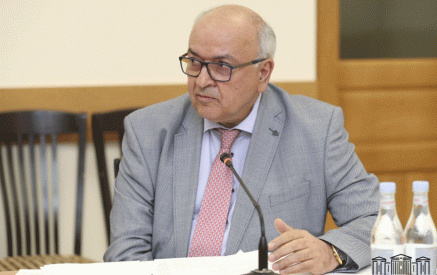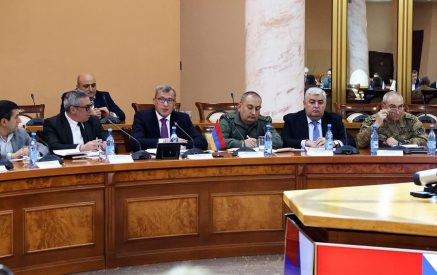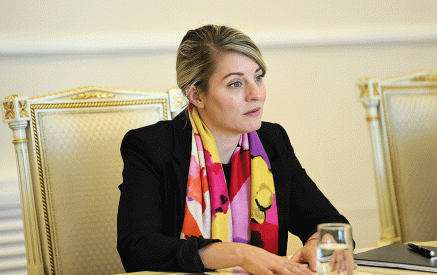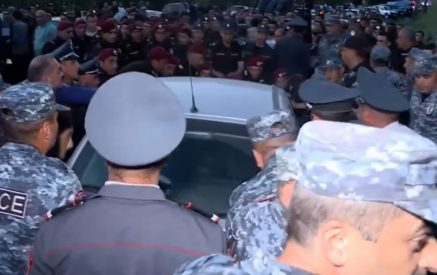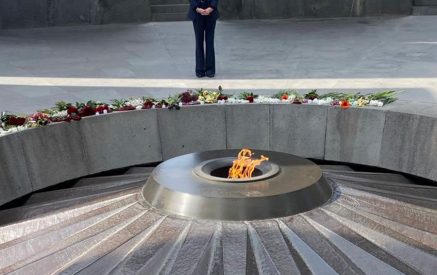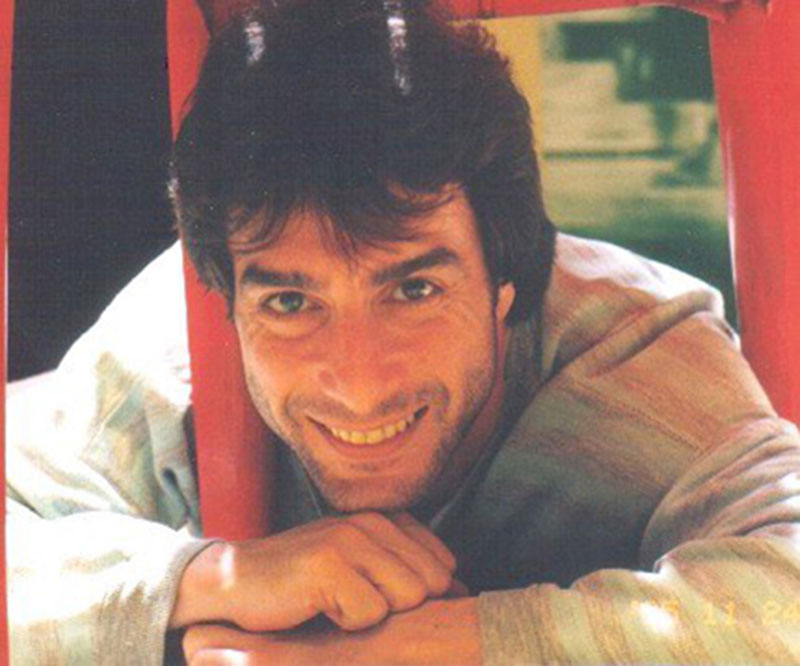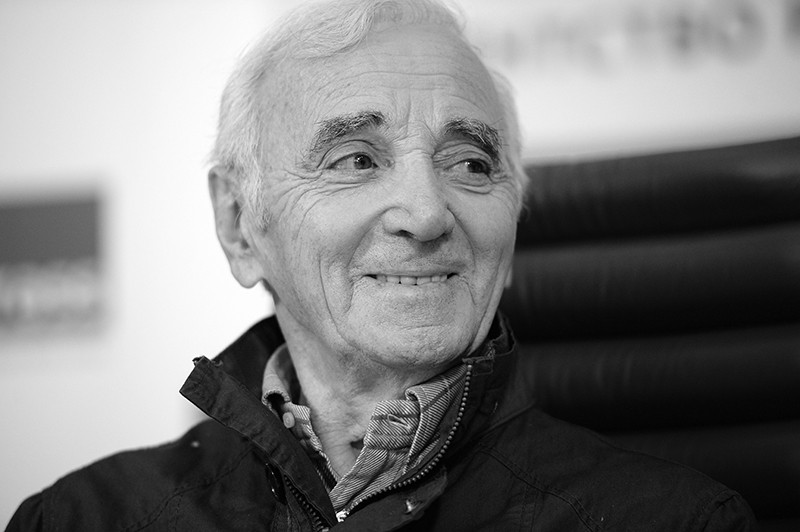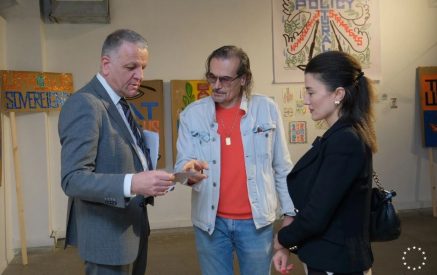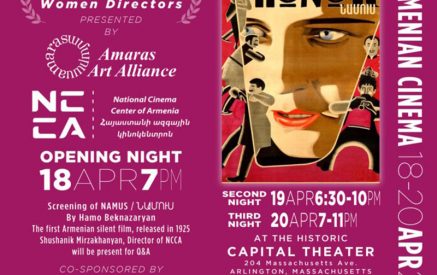by Artsvi Bakhchinyan
YEREVAN / SANTIAGO, Chile – Ballet dancer, teacher and choreologist Carlos Pablo Aharonian — the only choreologist in Latin America — was born in 1956 in Montevideo, Uruguay. He started his dance career in the Maralik Armenian dance company (led by Rosita Chakidjian) at age 12, followed by classical dance studies at 18 under Raoul Severo. He was a principal with the National Ballet of Uruguay (Sodre), soloist with Teatro alla Scala in Milan, principal with Carla Fracci Ballet Company, Teatro Communale di Bologna and Ballet Santiago in Chile. As a highly successful ballet dancer and later as a sought-after ballet master, he has left an indelible mark on many ballet companies around the world: Royal Ballet of Flanders, Royal Swedish Ballet, Western Australian Ballet, Korean National Ballet, Czech National Ballet, Staatsballett Berlin, Teatro Argentino de La Plata and Teatro Colon (Argentina), Theatro Municipal de Rio (Brasil). Pablo had the opportunity to work with and danced in choreographies by Marius Petipa, August Bournonville, John Cranko, Nicolas Beriozoff, Jerome Robbins, Glen Tetley, Uwe Scholz and others. His repertoire included “Swan Lake,” “Sleeping Beauty,” “Carmen,” “Coppelius the Wizard,” “Firebird,” “Cinderella,” “La Sylphide,” etc.
Aharonian was a guest teacher at many prominent places such as Central School of Ballet in London, San Francisco Ballet School, National Ballet Sodre in Uruguay or New Zealand School of Dance.
At the age of 43 Pablo Aharonian completed his studies in choreology (the Benesh Movement Notation) in London. As choreologist, he uses the Benesh Movement Notation to record choreographies especially by the Brazilian prima ballerina and choreographer Marcia Haydée. He joined the team of Ballet de Santiago in Chile with Ivan Nagy as artistic director. Later when Haydée took over as director, Pablo became “her” choreologist, responsible for staging her various choreographies around the globe. He continues to teach classical dance to this day and is the official re-stager of Marcia Haydée Trust, John Cranko Trust and Ivan Nagy Trust.
Dear Pablo, you have worked in various ballet companies on four continents. What differences have you noticed in approaches to ballet in different countries?
That is true, I have worked in many, many companies through many, many years. And not only dancing or staging ballets, but also working with technicians, lighting, etc. The dances are more or less the same all over the world, because the upbringing is more or less the same for everyone. Since early childhood in the ballet schools you are taught the most important things — the discipline and commitment — so almost most dances are very self-disciplined. In my case I always had a very nice experience with dances because I always go to the studios with my work ready, I never improvise and I always work very clearly with the pianist, the orchestra conductor and dancers. And the differences that you can find, are how the companies are organized, for example, how many hours of rehearsals they have, how long their trainings are, how long the lunch break is, how many days they work per week, etc. And, of course, how the director runs the company, but as I said, everything more or less is the same.
You have danced with many ballet luminaires — Rudolf Nureyev, Erik Bruhn, Svetlana Beriosova, Ronald Hynd, Ben Stevenson, Natalia Makarova, Marcia Haydée, Richard Cragun, Tamara Grigorieva, Olga Lepeshinskaya. What have you learned from them?
I was lucky to work with all those people. I not only danced with them, but worked, and they were my teachers.
Erik Bruhn was a gentleman, a very kind person, a great classical dancer and an amazing teacher. I worked with him at La Scala, he came as class teacher, and took two classes twice a day and it was amazing. His Danish school was very important, it was an asset.
Svetlana Beriosova was fan-tas-tic! She was the most beautiful dancer, very aristocratic, amazing and kind. I had a feeling I was working with an empress, with a queen. She came to La Scala to teach “Swan Lake” of her father, Nickolas Beriozov. She was beautiful in showing, beautiful in explaining, in everything! We became very good friends, and when I lived in London, I used to go and visit her regularly. I learned a lot from her. The roles I learned from her were quite unique. Her Odette-Odille for me is the best in the 20th century. I have many pictures and many nice memories.
Ronald Hynd was a great theater man, fantastic, you could learn a lot from that great choreographer and great human being with rich experience. He was teaching with enormous generosity. I danced many ballets with his choreography and I have lovely relationship with him too, thank God.
Natalia Makarova was a great star, who came to dance with us, and it was a great experience too. She came to teach us her version of “La Bayadere.” She was very strict, very clear, everything from Vaganova school but with time she became warmer, more communicative with the people.
Marcia Haydée is like family member for me. We have known each other since 1986, when she came to Chile to dance with Richard Cragun as guest stars in “The Taming of the Shrew,” and I danced with them. After that she directed our company twice, and I traveled with her around the world as her official re-stager and choreologist, teaching her ballets and working with her. We have a very dear and close relationship.
The same was with Richard Cragun, an amazing, lovely person and great dancer, with whom I danced in “The Taming of the Shrew” and “The Merry Widow.” Afterwards he became the coach of several ballet productions in Santiago. It was always pleasure to listen this beautiful person and great professional.
Tamara Grigorieva was a legend, who worked with Ballet Russe of Colonel de Basil. Everything she was speaking, about wonderful people and repertoire was a history of ballet, and she was a part of that history. This fantastic lady was extremely beautiful and with an amazing knowledge of ballet. She came to teach the old Ballet Russe repertoire. Grigorieva fell ill and because my father was a doctor, he examined her and became good friends with her too.
And Olga Lepeshinskaya came to La Scala for three months. She was a very good teacher, but strong and demanding. She was always telling old stories about Bolshoi and talking about big stars like Zhdanov, Ulanova, Plisetskaya, Fedicheev, Maximova, Vasilev.
All my life I was aware that I am meeting amazing personalities. I was very lucky to meet such people and learn a lot from them!
I admire Rudolf Nureyev. Some years ago I read Diane Solway’s voluminous biography of him. Are there any special moments connected to him you would like to share with?
I met Nureyev when I was at La Scala in 1980. I went to take a class there, and once Nureyev came and sat down to watch the class. He asked the director of the company to hire me for “Romeo and Juliet.” I danced the role of Mercutio’s friend. There were parts in choreography that I danced with Nureyev. As you know, he was an amazing personality, he was already in 40s, 43 I think, and he was a very hard-worker, pushing himself endlessly. And he liked me, thank God, because he had a very strong character. I think he liked me because he realized that I am a hard-worker too and respected me very much. One day I was in a big studio, Cechetti studio, doing fouetté and sauté. When Nureyev came, I stopped: in those days you froze in front of such personalities. And everybody knew he had a very impulsive character and no one knows how would he react. But he took of his coat and corrected me. He used always to correct little things during our trainings. So, I have very good memories of him. Nureyev was a great example to follow as a hard-worker. His knowledge was immense in history, costumes, you could learn so much only by observing him and listening to him.
I assume for you it was important in 1986 to be praised by Anna Kisselgoff, the severe ballet critic of New York Times.
It was January 1986. Yes, that was wonderful. It was about my role in ballet “Rosalinda” staged by Ronald Hynd with Johann Strauss music. In the third act I had a role with lots of turns and jumps, lots of technique. It was a funny comic role, and of course I was happy to have Kisselgoff’s review. Here another good thing was that a name of an Armenian was highlighted on the pages of New York Times.
You were invited as guest principal by the Stuttgart Ballet to dance the role of Offenbach in Maurice Béjart’s “Gaîté Parisienne.” Do you know that one of characters of this ballet is Ruzan Sarkisian – Béjart’s beloved teacher?
In those days I did not know, because we called her Madame Ruzan, until later I knew about her origin. I have a big collection of ballet books, so in one of them I learned she was an Armenian. When I met Béjart, he was very sick and aged, he did not speak too much, so I have not asked him about his teacher. But I was honored to act as Offenbach with lots of great dancers with Stuttgart company!
You were born to Astghik Aintablian and Kourken Vahaken Aharonian. How did they end up in Uruguay? Did they expose you to Armenian culture at home?
My paternal grandfather, Hovhannes Aharonyan, after leaving Zeytun first went to Jerusalem, where he was in charge of an orphanage. A part of the family was killed, some were lost, so they decided to move to America. It was incredible that in mid-1950s they found one of my father’s cousins. With his wife, Katarine Bostanian, my grandfather came to Uruguay, which was doing very well economically. Immigrants were very well-received, the climate was great, so they saw the possibility to live in peace in that very cultured country. Five of my grandfather’s sons survived — Arshak, Nubar, Sebuh, Aris and my father Kourken. The eldest one, Arshak, lived in United States, and later repatriated to Soviet Armenia, where he passed away. So, our whole family was very Armenian. Every Sunday I used to go to church as an altar boy and sarkavag, while my sister was in the choir. We were always speaking Armenian, although I never attended Armenian school. We went to a German school, but we were brought up very Armenian, listening to music on the radio — Aram Khachaturian, Arno Babajanyan, Armenian operas. My father used to read and write perfect Armenian, my eldest cousin too. My maternal grandparents were wonderful people too, Khacher Aintablian and Beatrice Manougian, they came to South America in 1924. My granny taught me how to read and write in Armenian, but I left Uruguay when I was 23 years old, so I never had any chance to use the language. Now in Chile I want to get it back and to find someone who can teach me Armenian again.
I assume you are connected to Uruguayan composer Coriún Aharonián (1940-2017)?
Yes, he was my first cousin, the son of my uncle Nubar. And my cousin Antaram Keghuhi Aharonian was a pianist and a very good friend with Aram Khachaturyan. When he came to conduct his piano concert in Montevideo, my family hosted him. In the collection of letters of Aram Khachaturian there are 12 letters addressed to Antaram.
Are you in touch with Armenians in Chile and do you have plans to visit Armenia?
In Chile I am not in touch with many Armenians, but I would love to. I went to the Hye Doun (Armenian House), which is very nice place and very close to where I live. But unfortunately, there are not many Armenians in Chile and very few of them speak Armenian. When I am at home, I think in Armenian, and when some Armenian artistes come to Chile, I do not lose the chance to meet them and talk in Armenian.
And of course, I would love to go to Armenia and to give there whatever I learned all around the world!

